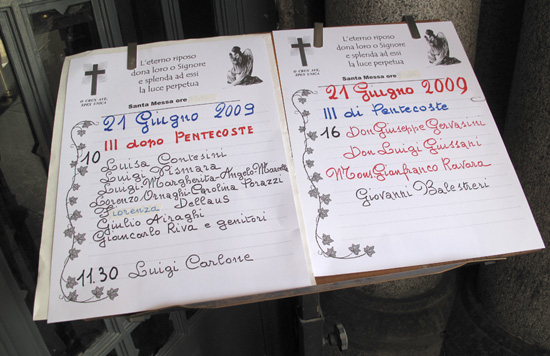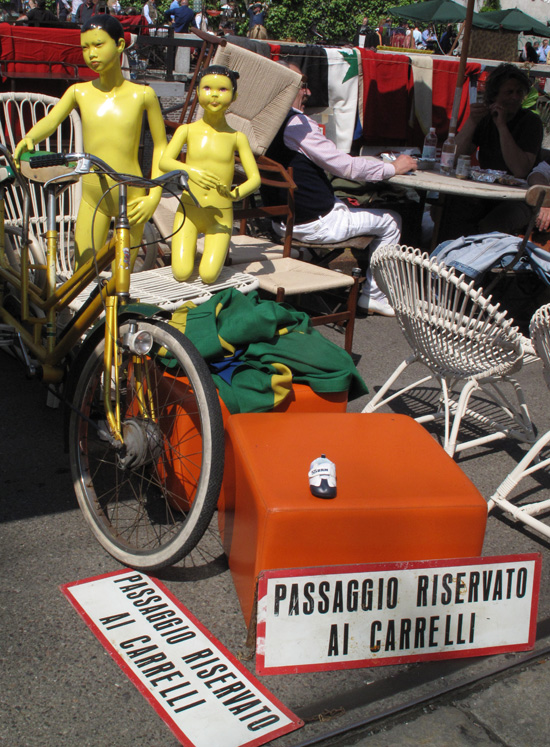
by Maureen | Apr 26, 2010 | Canals, Discoveries, Featured Articles, Journal, People, Photo of the Day, Photos, Shopping & Markets
On the last Sunday of the month, one can browse Antiques and Flea-Market-Finds for as far as the eye can see (2 kilometers), on both sides of the Naviglio Grande, the Grand Canal. (This canal intersects with the Naviglio Pavese, the one I ride my bike along.)
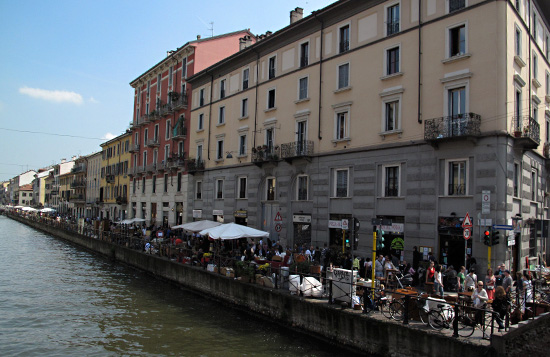
.
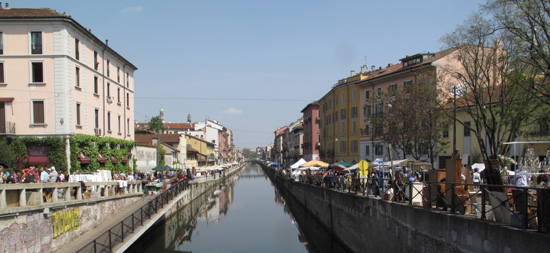
.

There is still some limited boat traffic along the canal when they’ve let the water in.
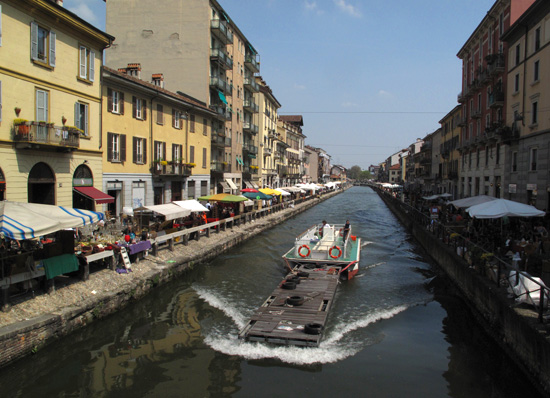
The antique sellers’ stalls also stretch far out into the side streets that branch off of the canal.
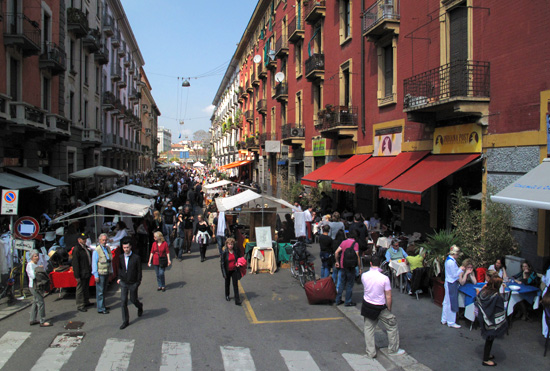
Linens? Oh yes. I find plenty. And they’re gorgeous. And the sellers know what they have and charge prices accordingly. There are few, if any, “steals” here. But the high quality linen and cotton, with the embroidery and open-work stitching, are superb examples of the old European linens. (I would love to buy them all up… but for what?)
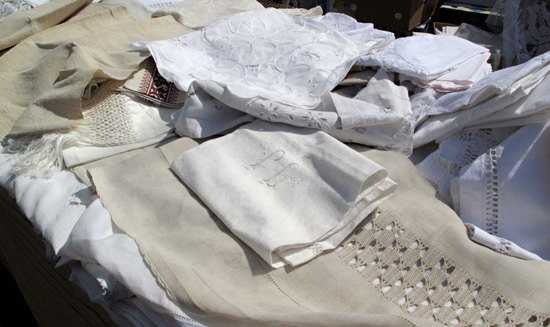
.
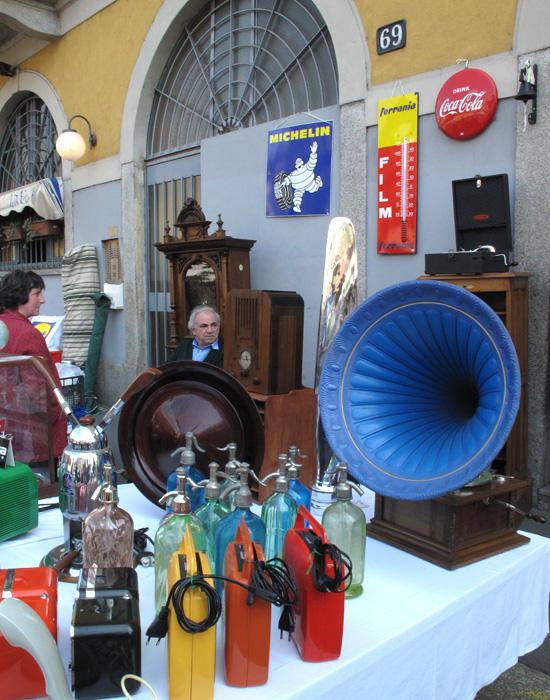
.
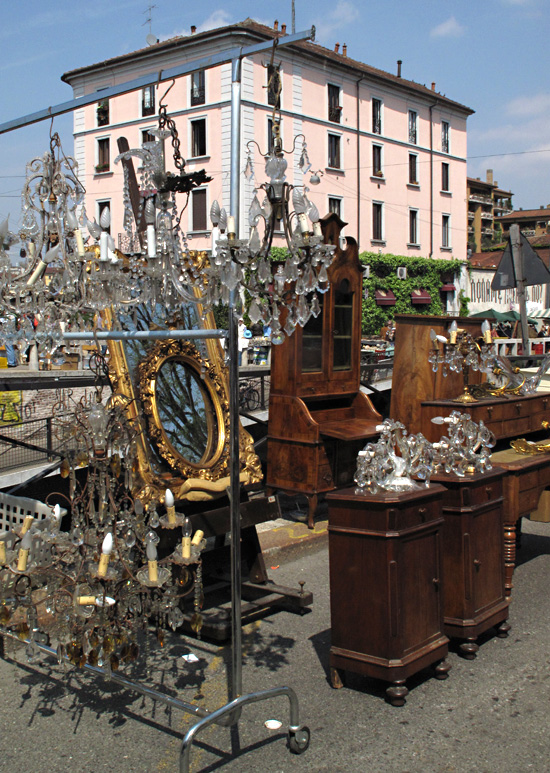
.
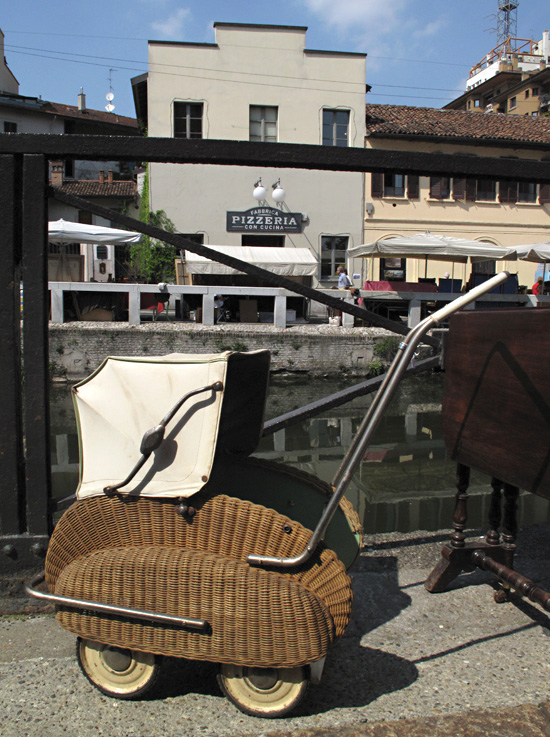
.
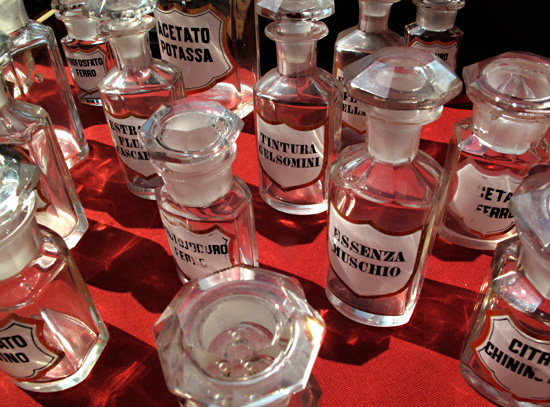
Beautiful, finely-crafted instruments of all sorts! The asking price of this Astrolabe was 700 Euro. (Cough, cough. Roughly $1000 right now.) But it was lovely.
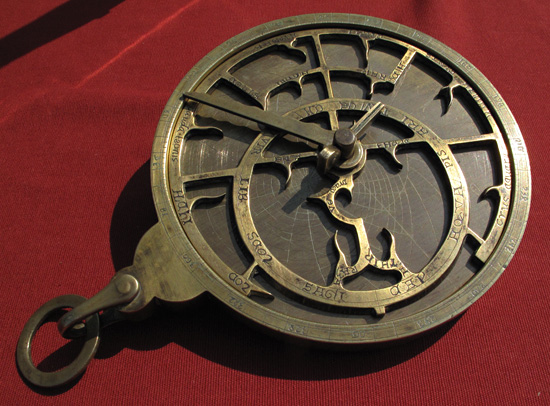
I don’t even know what this Parisian instrument is.
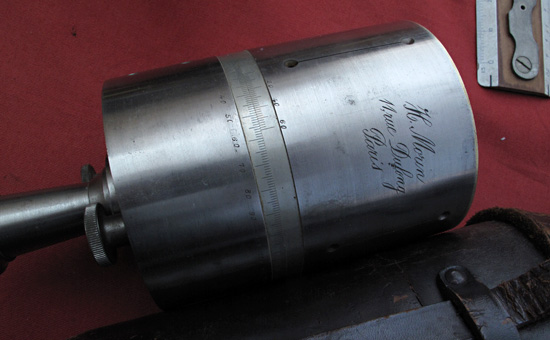
These look like porcelain portraits of Mao and his family.
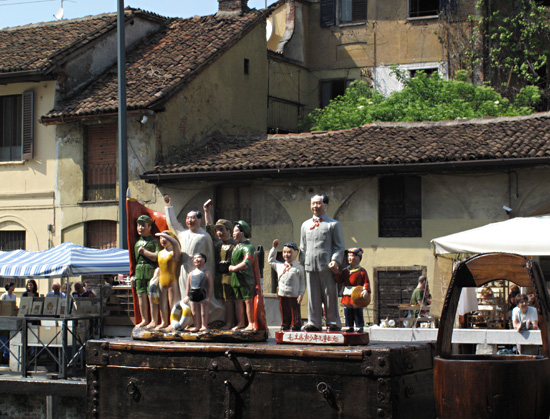
An interesting assortment of portraits.
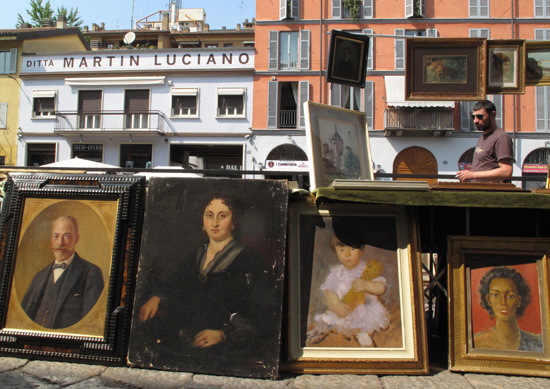
It is startling to me how often I see the American flag, or some representation of it.
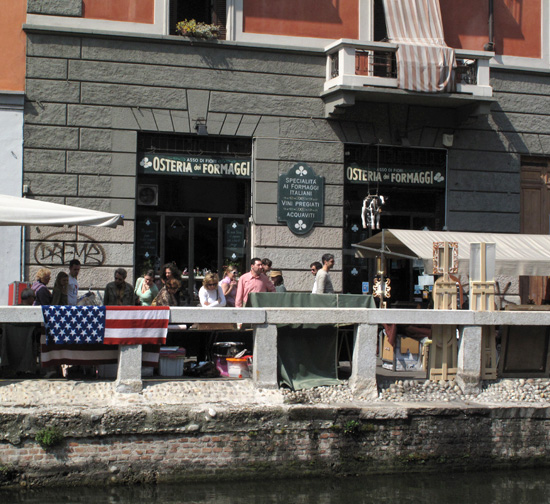
Isn’t this luggage out of the stereotypical “Italian Holiday Travel Movie”?
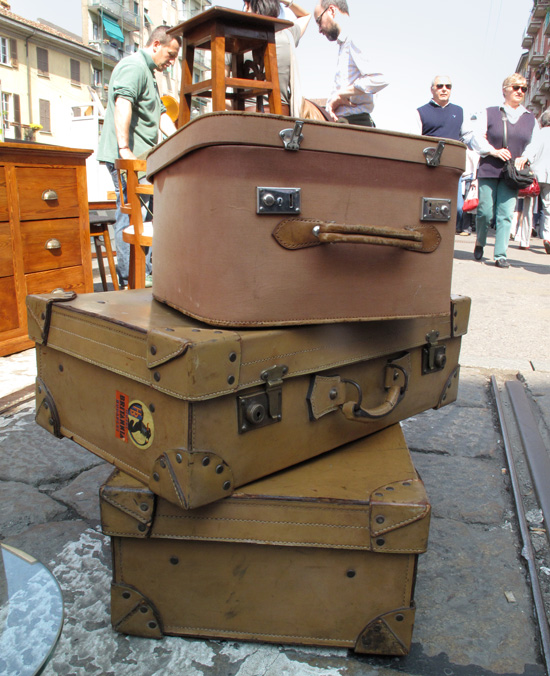
The dog matches the upholstery. I missed him at first.
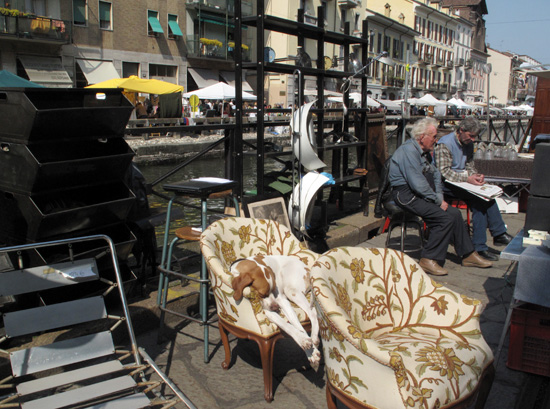
.
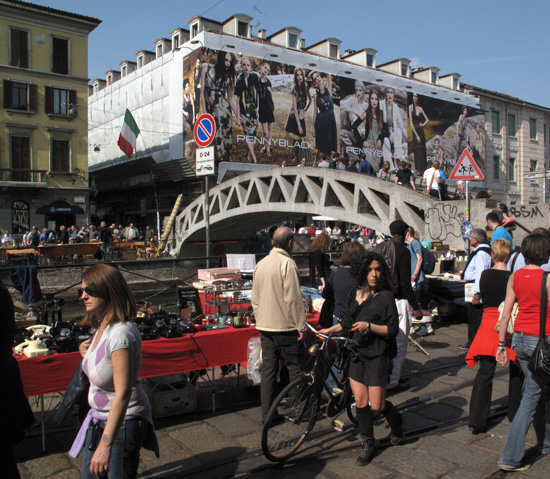
Smile. I’m on Candid Camera (for my Seester.)
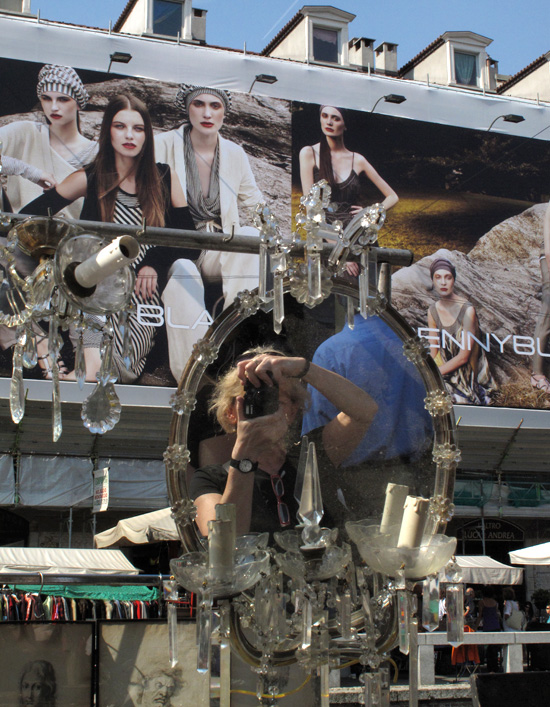
.
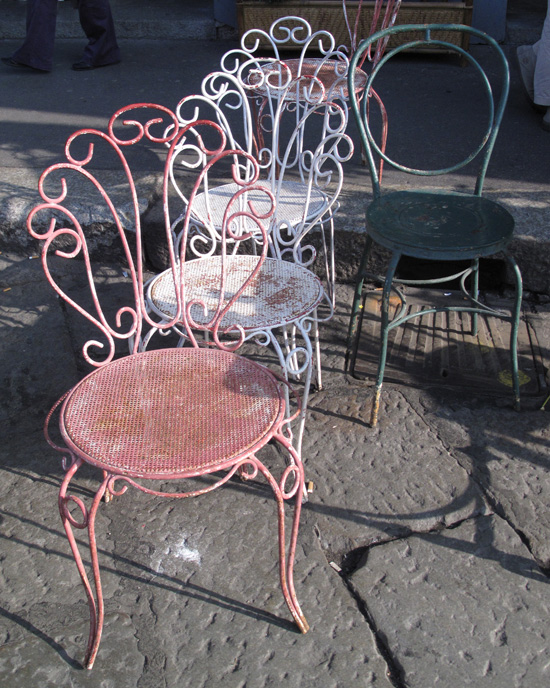
This guy sold horse figures of every sort.
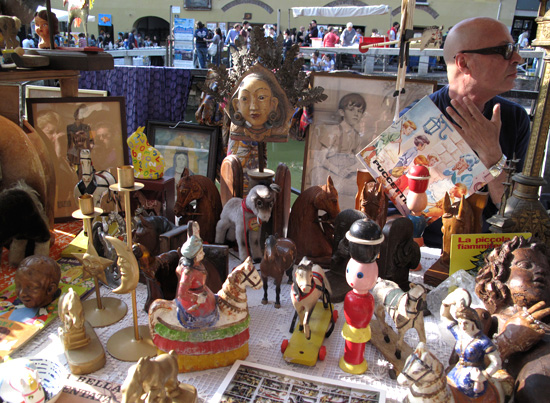
I had been walking around for hours and stumbled upon some finds. “How much for this group of papers and books?” “50 Euro.” “How about 40?” How about 45 and you let me buy you a drink.” I laughed. It caught me completely by surprise. I bought the papers and books for 45 Euro and Graziano and I stepped 10 feet across the cobblestone and had a glass of cold white wine at a Sushi Bar on a hot afternoon and talked for a little while. So funny. But it was a pleasant and charming break.
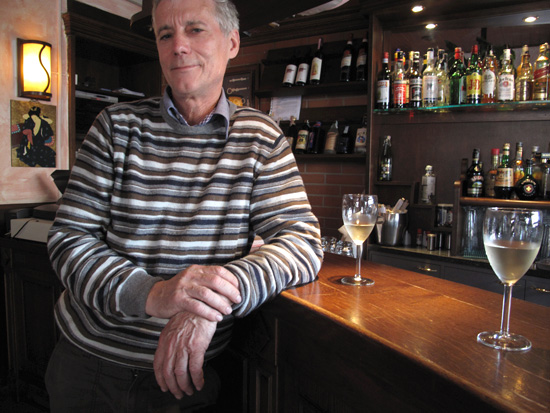
Cool hat box. (Cool typography.)
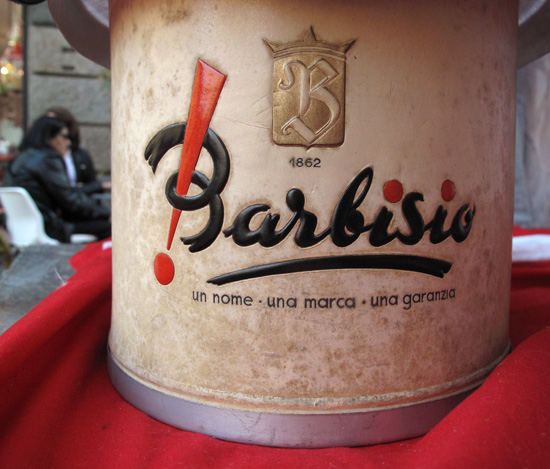
As the warm afternoon waned, the cafés started to fill with people enjoying the Milanese aperitivo. The musicians showed up in the old Vicolo dei Lavandai, the washing station of the 19th century where women gathered to scour their clothes against washboard stones as their wash water flowed off into the canal.
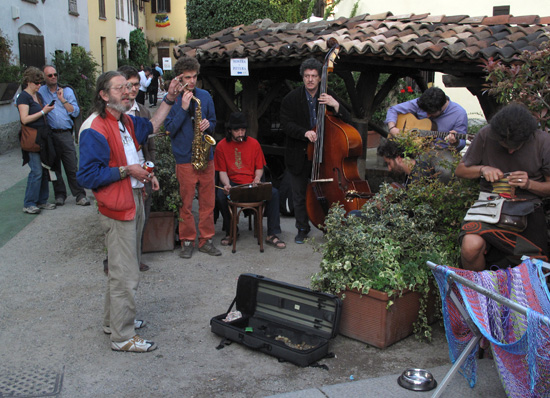
Who’da thought I’d see this?! Wait! I should have bought the one a few issues back: Settembre 1957!
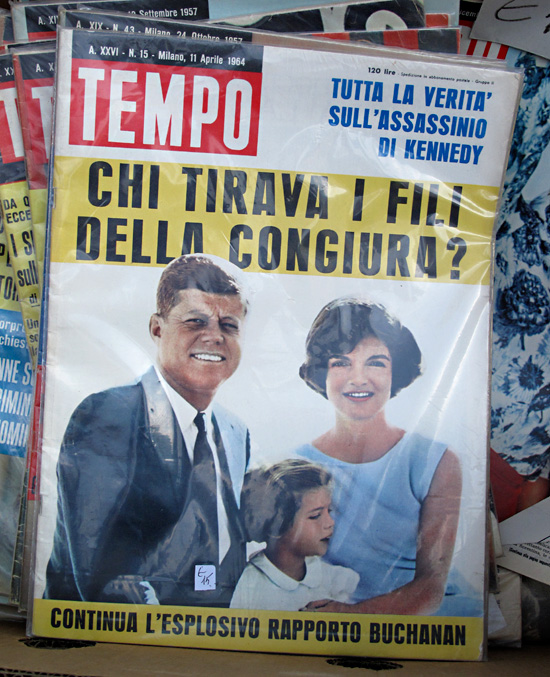
Packing up to go home, this man still wore hat, bow tie and white coat as he packed his lamps into a salami box.
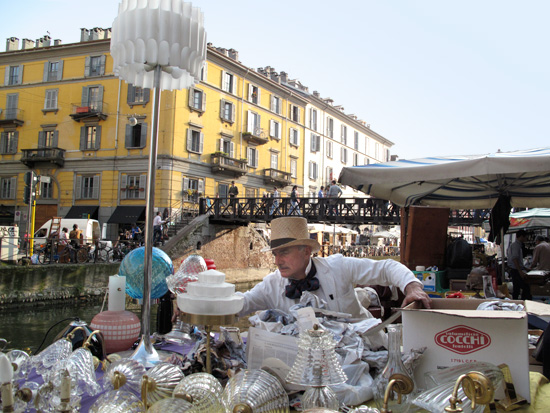
So now, do you have an idea of what’s for sale at an Italian Antique/Flea Market?
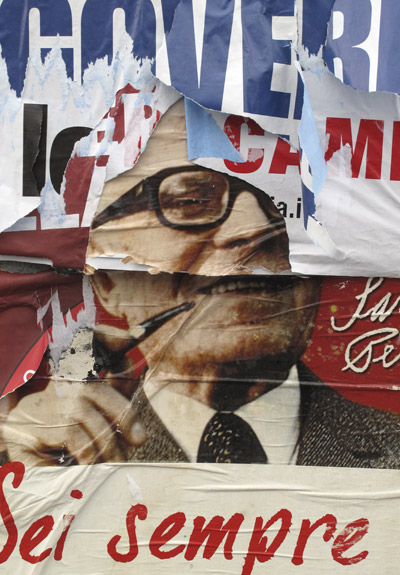
by Maureen | Apr 2, 2010 | Discoveries, Featured Articles, Graffiti & Street Art, Graphics, Journal, People, Photo of the Day, Photos
They put the temporary, scaffold-and-tin poster walls back up in my neighborhood just in time to feature advertising for the regional elections. Three inch holes are bored into the sidewalk, with rubber plugs for the off-season. Overnight, they can pop the plugs and throw up the walls clean and ready to be weighted with soon-flaking layers of advertising.
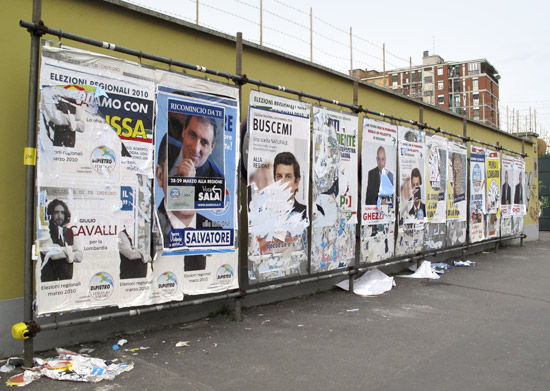
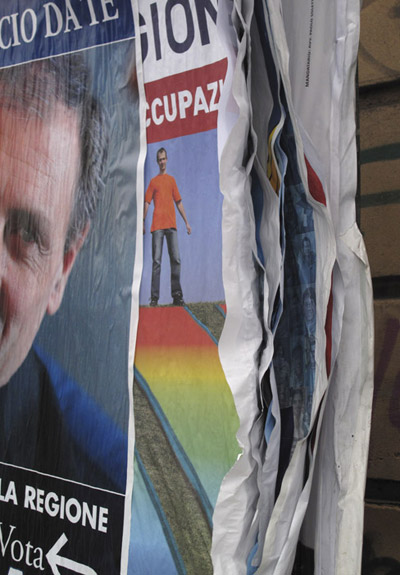
The other day, I was amused that as time, rains and passersby have swept past, the portraits on the political posters have been “enhanced”.
Isn’t this one “Art with a capital A”, all on its own!? It’s my favorite.

.
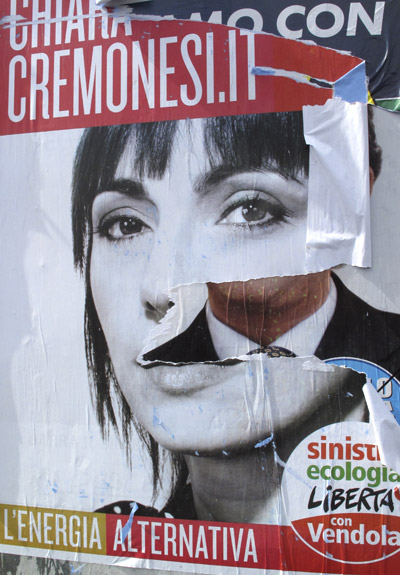
.
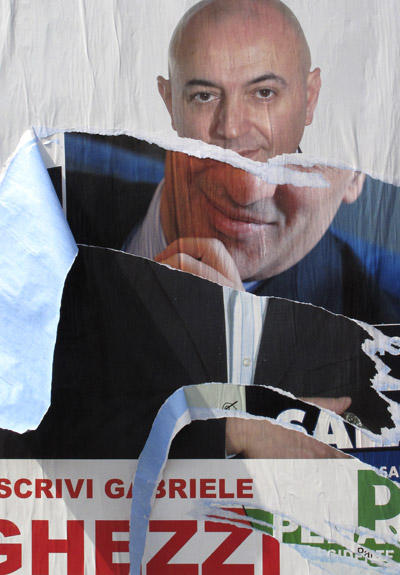
Somehow, “bellezza” – beauty – seems an appropriate headline for this dandy.
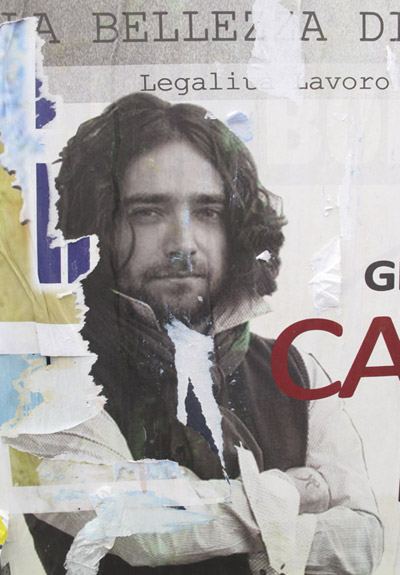
And, side-by-side, this man was fortunate to have two renditions of his portrait.
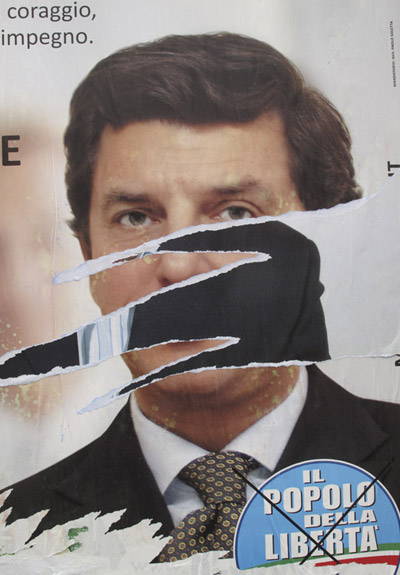
The word showing through the peeled section below – “vincere” – means “to win”. Hmm. Subtle.
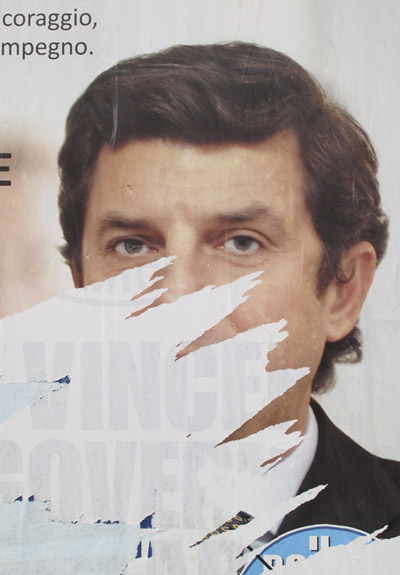
.
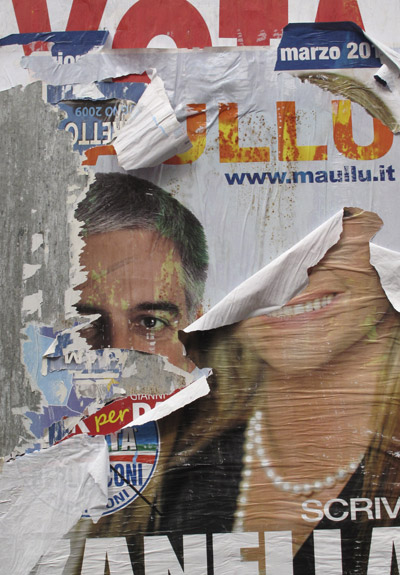
.
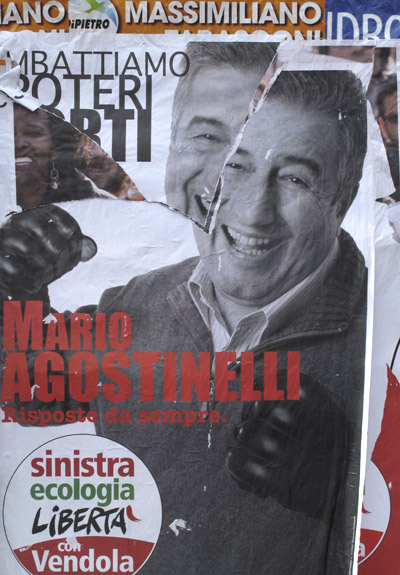
.
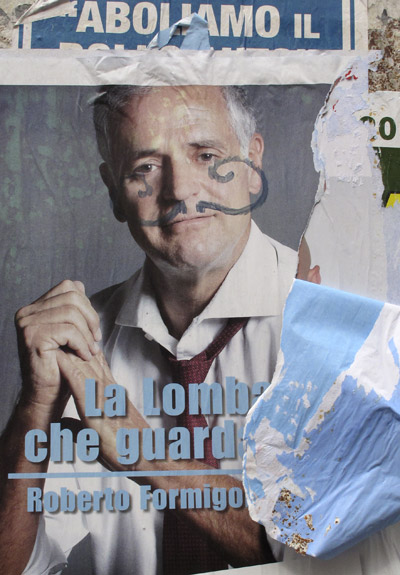
.
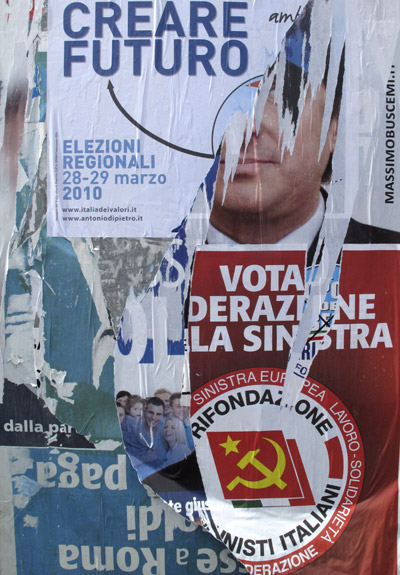
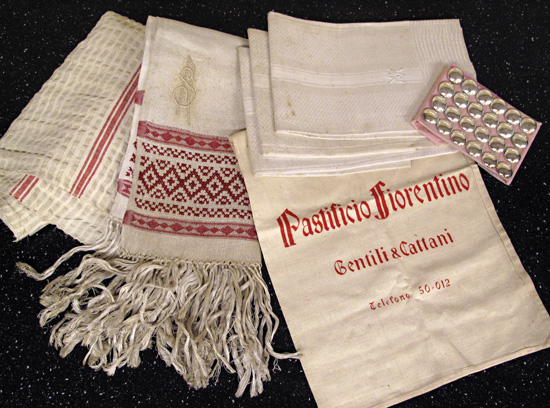
by Maureen | Mar 30, 2010 | Discoveries, Featured Articles, Firenze, Incredible Locations, Journal, Photos, Shopping & Markets
It was as a Camp Fire Girl in fifth grade that I learned to sew by stitching along the lines of binder paper. I’ve been sewing by machine and by hand ever since and fabric is one of the things that makes my heart rate pick up. (Literally.) So, put me in a place where I can find antique fabric, handwork and sewing “notions” and I think I’ve gone to heaven. I passed up some red-on-white cross-stitch samplers from the late 1800s either because they weren’t well-wrought, or the price was higher than I was willing to spring for. I did bring home this little bundle which I will wash up and actually use: embroidered hand towels and napkins, sterling buttons and a muslin flour sack. (I’m easily amused.)

Can you believe I found MY initials embroidered?!
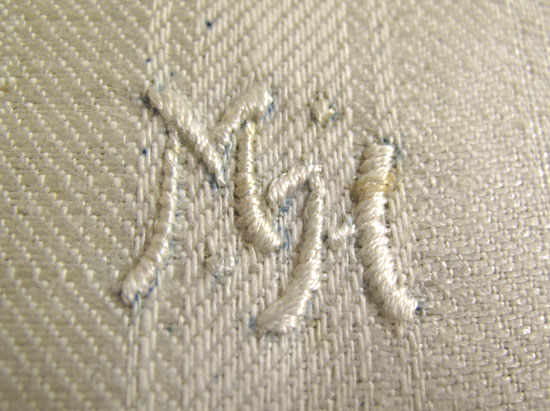
There was a box of about 10 dozen sterling silver buttons produced for Italian military uniforms. Each is marked with “Milano” on the back, which I think is more beautiful than the high-polish front. (I’ll take steel wool to the surface to rough them up, then use them on a special jacket I’ll make.)
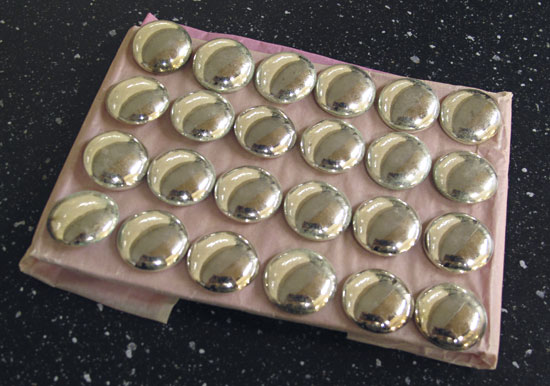
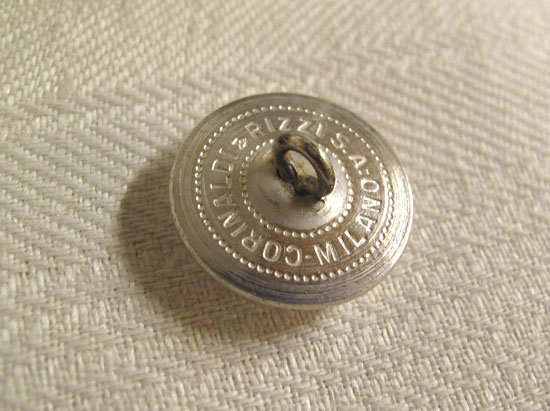
This is elaborate raised stitching on the damask, woven patten.
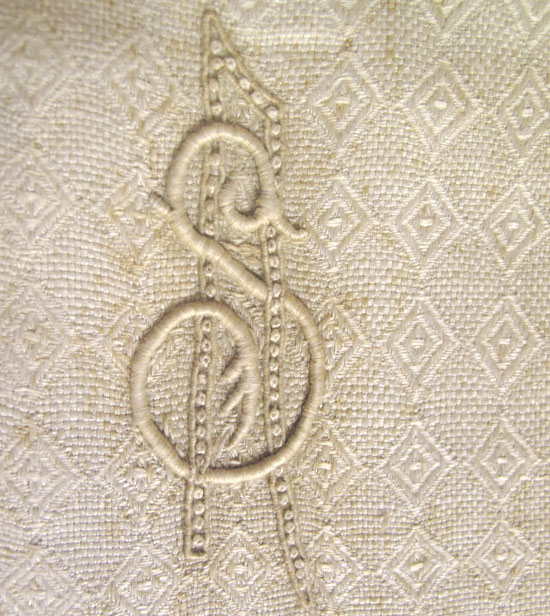
This fringed towel features hand-wrought, counted cross-stitch in between two woven borders.
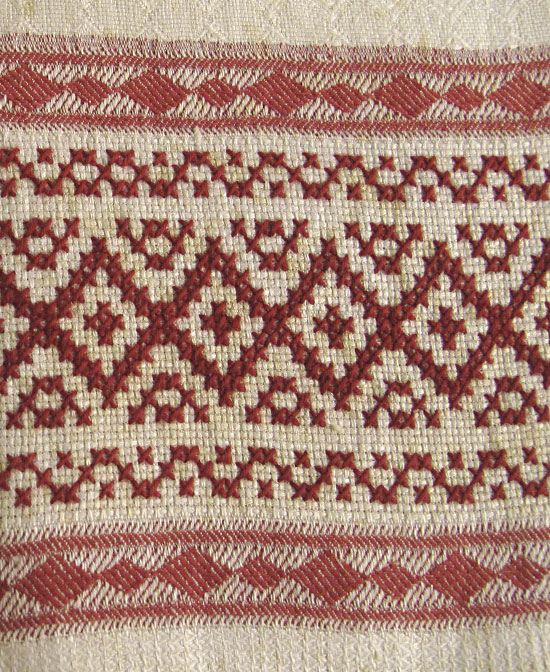
This was a sign on the door of a little shop where they do “polishing, lacquering, restoration and gilding” and sell antique furniture and frames. “Excuse me, would you be willing to sell your sign?”
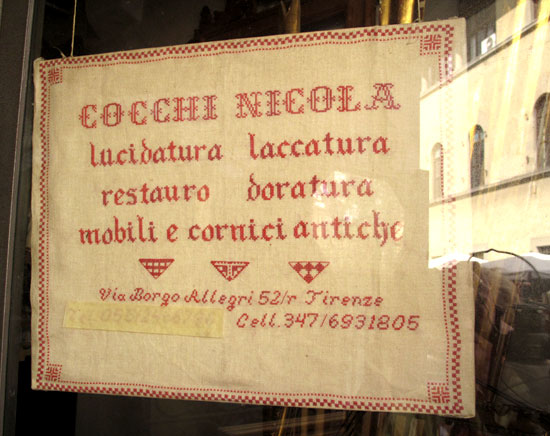
The sellers of this piece were out to lunch. I waited around but they didn’t return, so I simply photographed it. This is a religious symbol for Mary, Mother of God. The “AM” monogram stands for “Ave Maria”. I’ve seen this symbol other places in Italy, such as the cathedral in San Giovanni Valdarno when I was there 2 years ago.
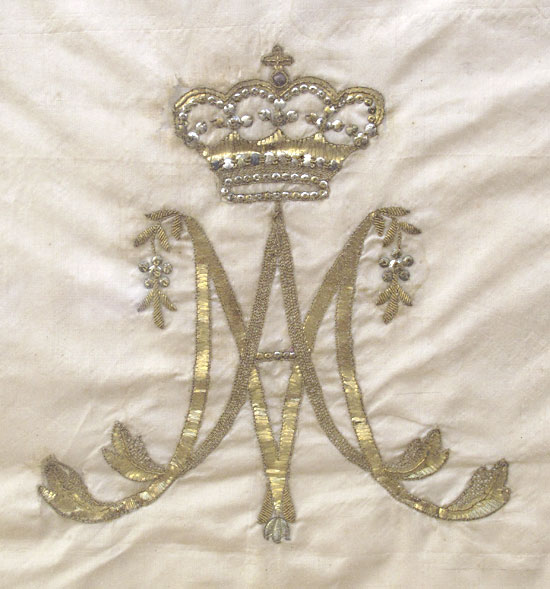
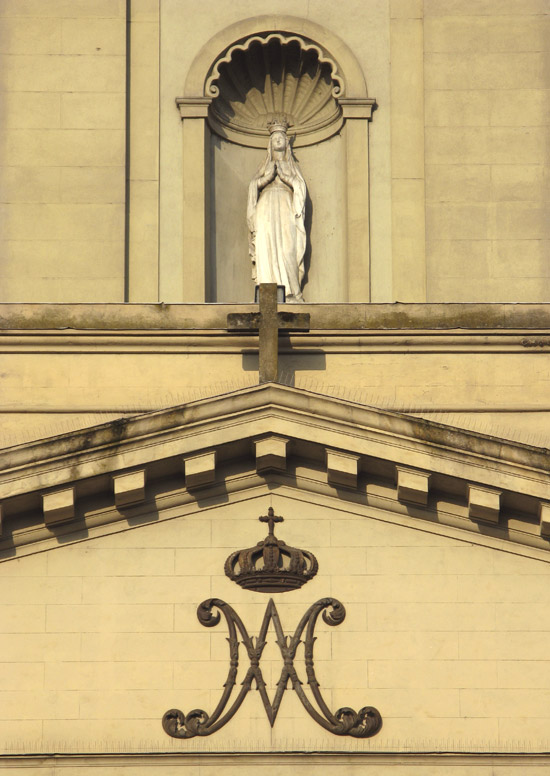
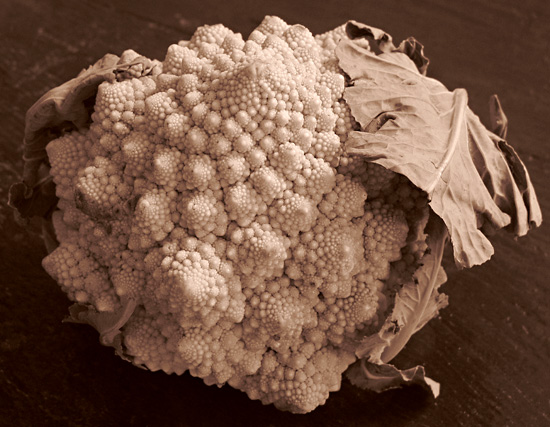
by Maureen | Mar 24, 2010 | Discoveries, Featured Articles, Food!, Journal, Photo of the Day, Photos
They call it “Cavolfiore” or Cauliflower here, but Americans call it “Romanesco Broccoli”. Either way, it tastes great, it’s absolutely beautiful, and it’s math on your plate.

The Romanesco is a clear example of fractals and the fibonacci number sequence.
See how the whole head of Romanesco is made of smaller heads that mimic the shape of the bigger head, and each of those smaller heads is made of even smaller, duplicate heads? Fractals!
FRACTALS: “A fractal is a rough or fragmented geometric shape that can be split into parts, each of which is (at least approximately) a reduced-size copy of the whole… Because they appear similar at all levels of magnification, fractals are often considered to be infinitely complex (in informal terms).” (Check Wikipedia for cool examples and further explanation: http://en.wikipedia.org/wiki/Fractal)
And you see the ever-expanding spiral emanating from the center point along which all the smaller heads are arranged? The Fibonacci sequence and the Fibonacci spiral!
FIBONACCI: “In the Fibonacci sequence of numbers, each number is the sum of the previous two numbers, starting with 0 and 1. Thus the sequence begins 0, 1, 1, 2, 3, 5, 8, 13, 21, 34, 55, 89, 144, 233, 377, 610 etc.” (Wikipedia, http://en.wikipedia.org/wiki/Fibonacci)
Click HERE for a beautiful video by Cristóbal Vila about numbers as they establish patterns in nature.
*TWO words are Italian!
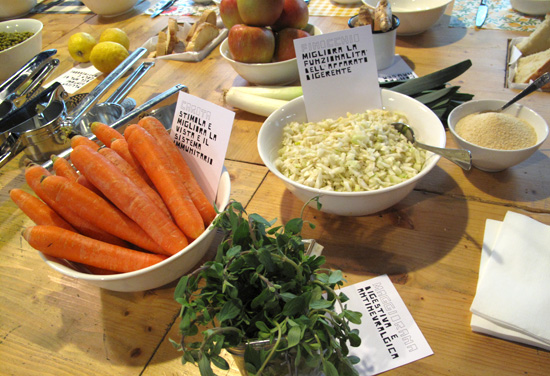
by Maureen | Mar 21, 2010 | Cheese, Discoveries, Featured Articles, Food!, Introspection, Journal, Meals, People, Photo of the Day, Photos
Would you let 30 random strangers eat off your plate? Would you, in turn, eat off the plates of those 30 strangers?
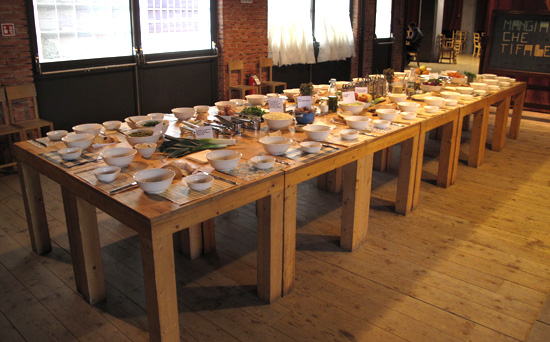
The Uovo Performing Arts Festival included one “performance” yesterday of 30 individuals, by reservation only. “Mangia che ti fa bene”, “Eat that you will feel well.” For 10 euro, or about $13.50, I walked into the room to a very long table with 30 place settings, and a variety of ingredients:
- bread
- water
- eggs
- grana cheese
- cabbage
- parsley
- apples
- beets
- sesame seeds
- pumpkin seeds
- fennel
- olive oil
- garlic
- spices
- cooked peas
- oats
- radicchio
- spinach
- fresh ginger
- lemon
- leeks
- carrots
- walnuts
- fresh herbs

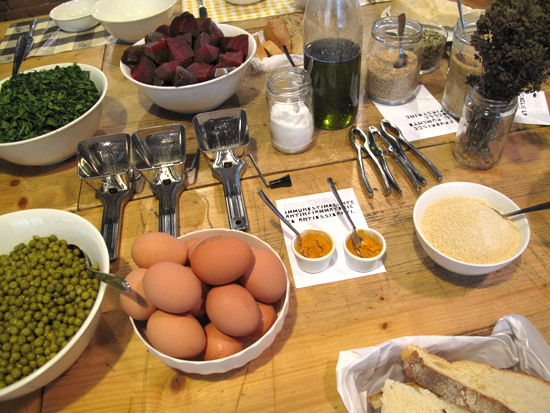
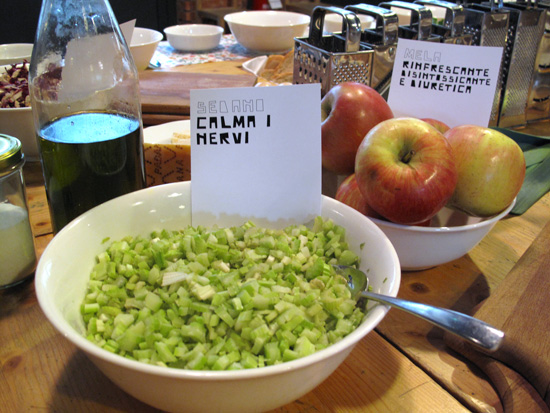
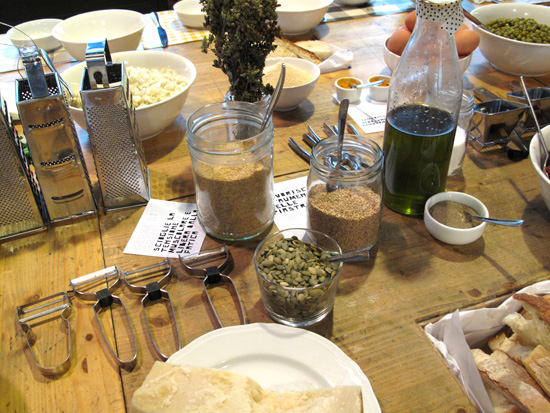
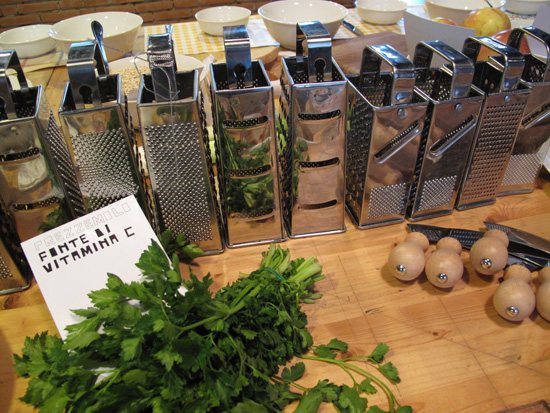
We were given limited, very loose guidelines.
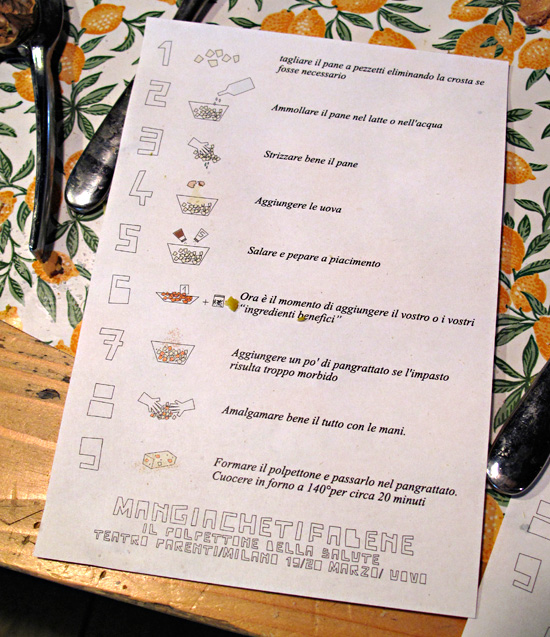
We each grabbed a plastic apron from the group taped to the window.
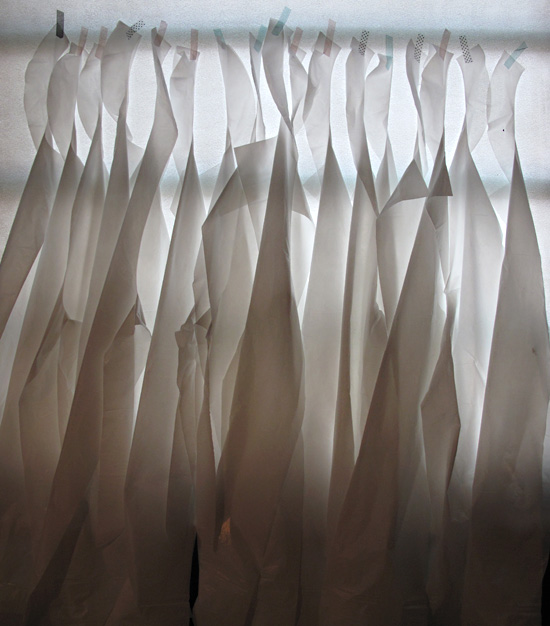
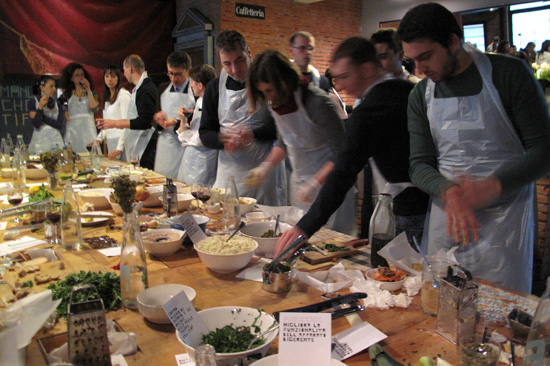
Our project was to gather whatever combination of ingredients we desired, blend them and put the mix into a paper-lined, 3″ x 5″ foil pan. The 30 of us were elbow-to-elbow at the table and we were being filmed. We had graters, sieves, knives, bowls, half-moons and cutting boards at our disposal. Notes were provided about the health-inducing properties of each food item.
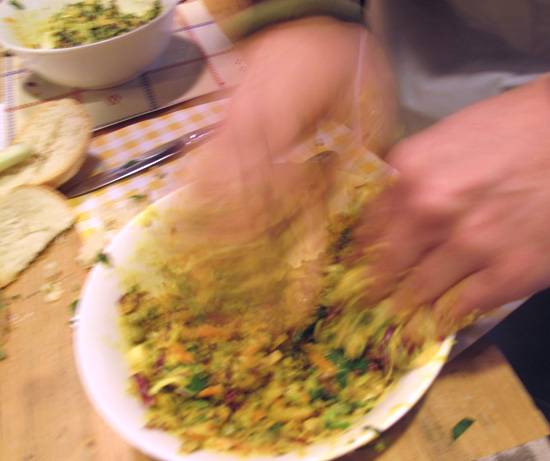
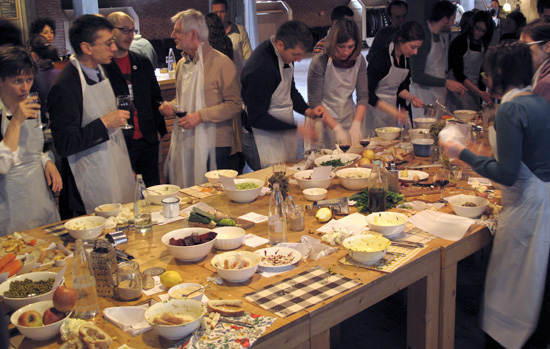
We asked for ingredients to be passed. We reached across the table. We laughed and chatted and mixed with our hands until our concoctions looked just right to us. Some pressed the ingredients through sieves for a uniform consistency. Others left chunks for spikes of flavor. Some formed loaf-like logs, while others patted their mix into flat casseroles. We bound up our creations in oven paper, scrawled our names on the wrap and sent the little tins off to be baked for 30-45 minutes.
While our dinners were baking, we were served lemon-slice salad, celery sticks with honey, and braised celeriac root. For our 10 euro, we also got a glass of red wine and some herb tea.
Trays of foil tins emerged from the oven, and the hostess called out names. One-by-one, the “performers”, the dinner guests, opened and tasted their creations. There were 30 recipes at the table. Like a groundswell, the sampling started. People reached over with their forks and sampled their neighbors’ meals, and everyone started passing their dish around for others to taste. It was remarkable the range of culinary directions we had each taken. I realized later that I could have gone in the sweet direction and combined bread, egg, apple, ginger, lemon and arrived at a dessert to contrast with all the savory gratins at the table.
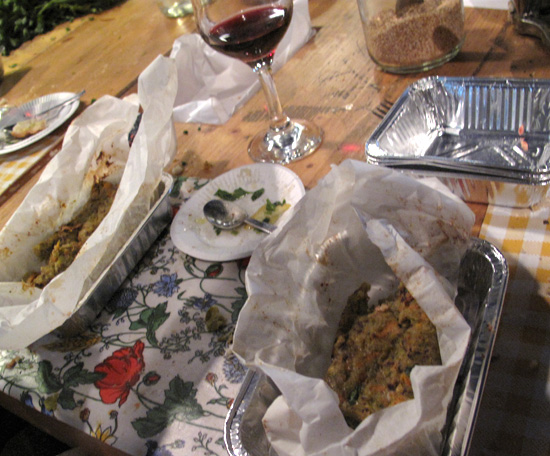
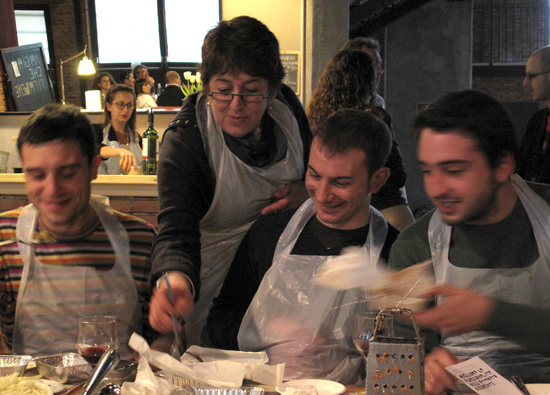
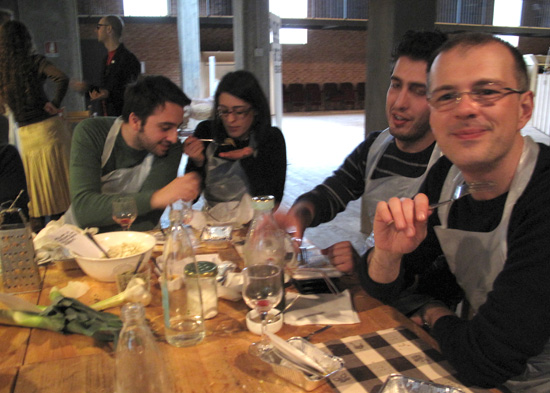
I looked around, tickled, chuckling and amazed. Would this happen in the U.S.? Could it? How could I bring this experience to Seattle? To Burien? I easily tallied that the 30 people at 10 euros each only brought in 300 euros. And I looked at all the food, and the utensils, and the wine and thought that surely this was not a money-making proposition. In the U.S., liability insurance alone for a one-day event of this nature would probably be prohibitive.
And would people in the U.S. be willing to pass their dish for their unknown neighbor to sample from, and then fork a bite from their neighbor’s plate and relish the combination of ingredients different from their own?
This does give me ideas for an uncommon Thanksgiving dinner… but many in my family would likely balk at the idea. (But they wouldn’t be random strangers.)
– – – –
Here’s the official, “as advertised” description of the event:
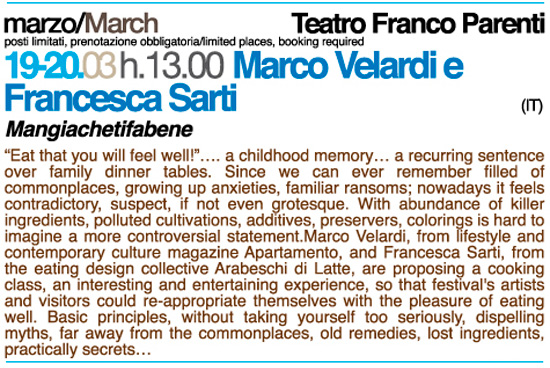
The aftermath was a mess of a table!
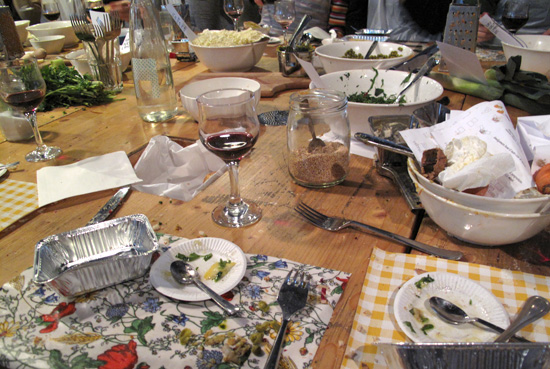
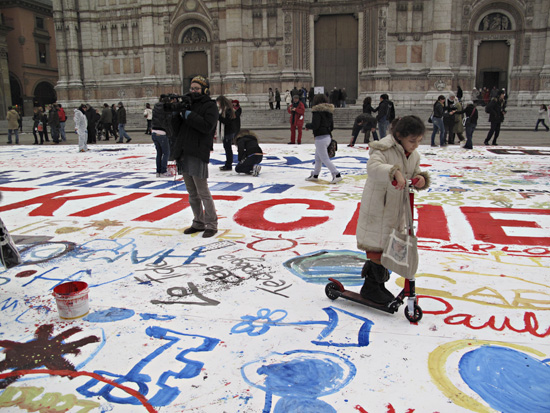
by Maureen | Feb 1, 2010 | Bologna, Discoveries, Featured Articles, Graffiti & Street Art, Incredible Locations, Journal, People, Photos
Scatter sculpture, paintings and installations in amongst mediaeval buildings and you’ve got the makings of a visually exciting weekend! The Bologna Arte Fiera got me into town, but I went about seeing it in a very random manner. I simply stumbled upon the art pieces as I found them.
The piece that was most delightful to me was the very spontaneous, casual creation of a “ground mural” out in front of Bologna’s duomo, San Petronio Basilica. The piece was conceived of by Art Kitchen. They had FILLED the huge Piazza Maggiore with a sheet of paper (pieces unrolled and then attached at the edges), then provided buckets of paint and brushes for anyone that wished to contribute. Families strolled on top of the painting. A little girl pushed by on her scooter. And one man used a push broom to make wide, sweeping black strokes. The piece was interactive and engaging. (These days, those two adjectives are usually applied to electronics and video games.)
Across the middle of the paper, they had painted “Art Kitchen: Make the Sky Bloom.”
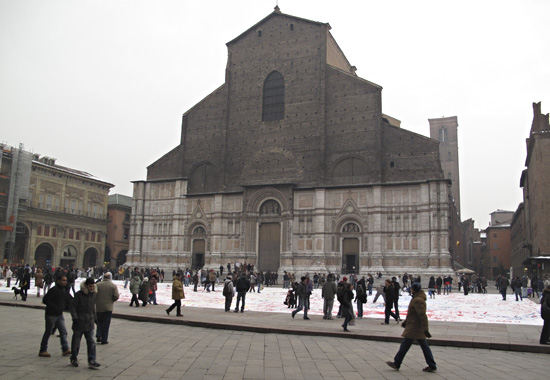
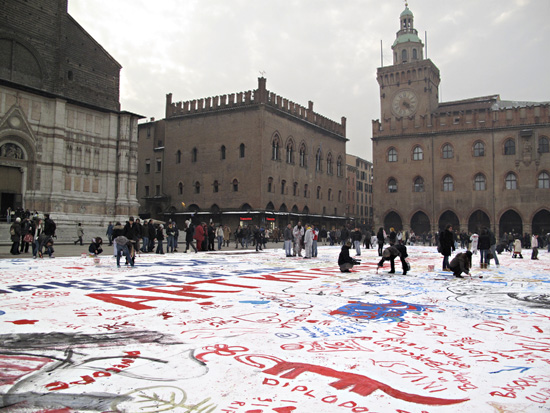

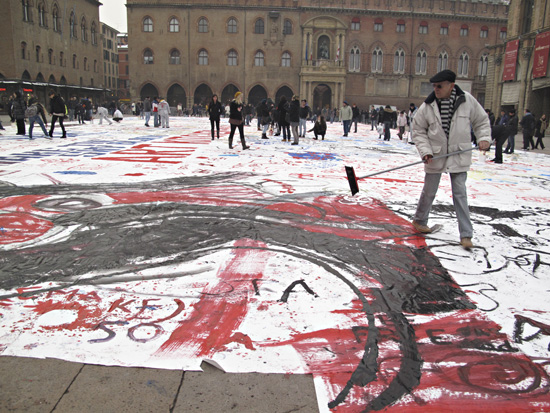
When I had just arrived in town and not far from the train station, I found a group clad in white, disposable coveralls creating this piece. Take note of the chunks of snow/ice they’re using to weigh the paper down.
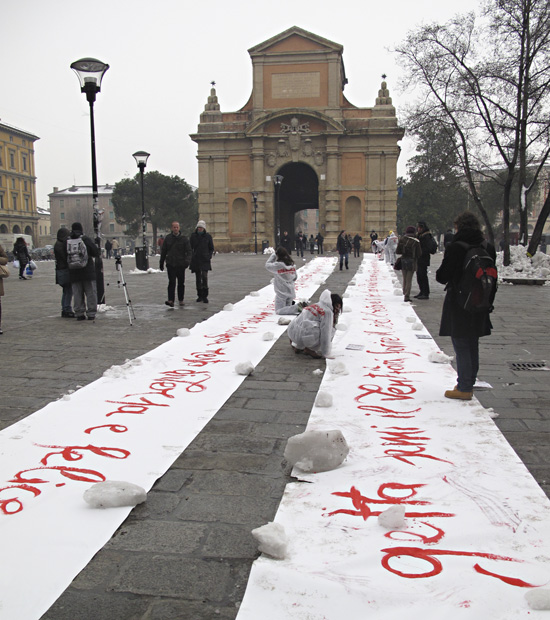
The other art included large, sculptural pieces, flat work and installations. Some I liked; some I didn’t like at all, (but that’s art for ya).
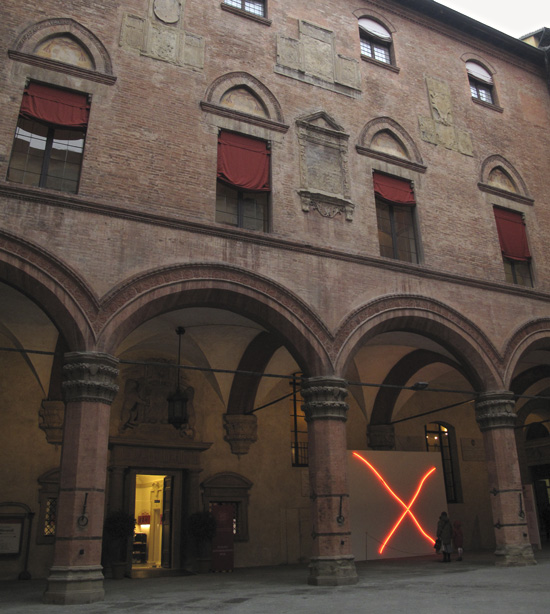
(I want this stone furniture in my yard! It wasn’t a part of the art fair, but shared the courtyard with the sculptural figure behind it.)
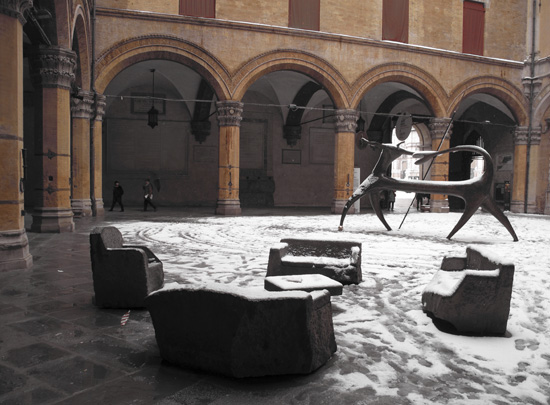
And this installation amused me most after my moment of recognition: they’re drafting templates for engineering drawings! Relics now, I have a drawer full of them in my basement in Seattle but haven’t used them for over 20 years.
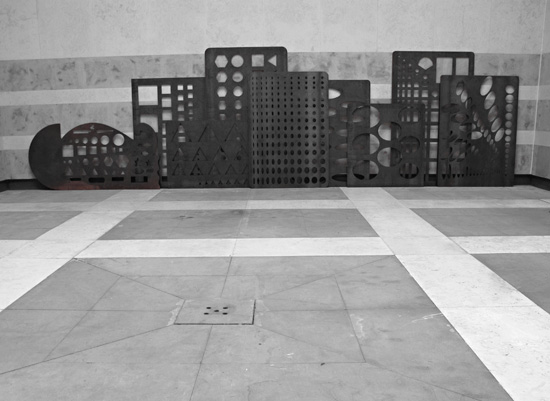
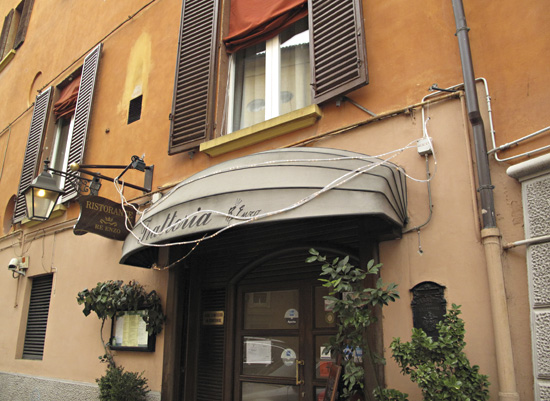
by Maureen | Feb 1, 2010 | Bologna, Discoveries, Food!, Incredible Locations, Journal, Meals, Photos
OK. So add Bologna to my list of amazing places to visit in Italy. It’s right up there with Venice, (which makes me swoon). I have a feeling the list will get VERY long.
A girlfriend from my Italian class had mentioned the citywide art fair, Bologna Arte Fiera, that was going on for a month starting 29 January. “Why don’t you come?”, she suggested. I quickly put plans in place and then hopped on the train Saturday morning.
(Side note: I had bought a ticket for the Frecciarossa fast train, which takes 1 hour instead of 3 and costs 41 euro instead of 11. I read the reader board, saw a train listed for Bologna – but with a 5 minute later departure than my scheduled train – and then hopped on the train and got settled into my seat. An hour into the ride, we weren’t even halfway there and were stopping at every little train station along the way. Uh-oh. I goofed. I had hopped on the slow train instead! Clearly I haven’t learned all the little details yet! Oh well. So I arrived later and saw each little town from the trackside. If there’s one thing I’m learning by being here, it’s to take things in stride, and let them roll off me.)
When I arrived in Bologna I walked a short distance to my hotel, I Portici, dropped my few things in the room then left and took off walking, having no idea where I was going or what there was to see! (Since making this trip was a spontaneous decision, I had only glanced at the site for the art fair, but not Bologna itself.)
I followed my “rule” of exploring the back streets, and found a little restaurant, Re Enzo Ristorante. As I was perusing the menu, the owner/waiter hustled past me with a cloud of truffle scent following him. That made my decision easy! “Scialatelli con Porcini e Tartuffo Bianco” – a wide, flat pasta noodle with porcini mushrooms and white truffles. I added some grilled vegetables to my table, and a nice Sangiovese to sip and the lunch was delicious.

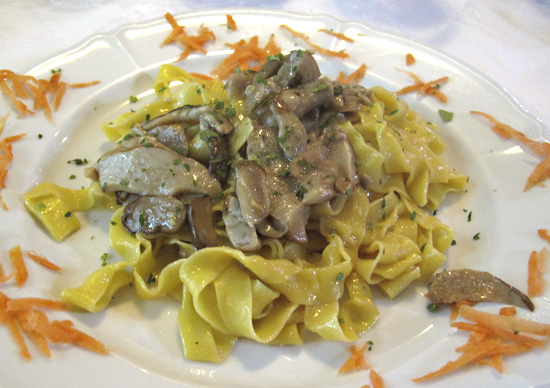
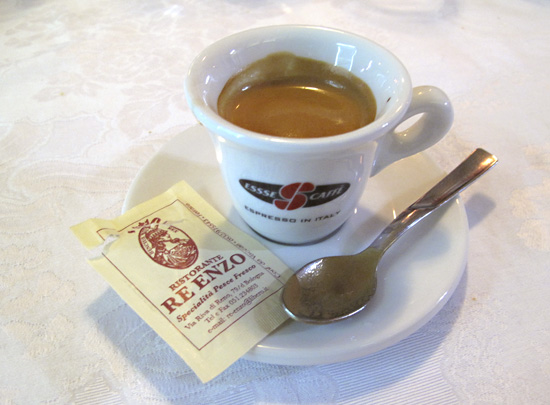
Well-fortified and hunger sated, I started walking around town taking turns whenever I wished and found my way to the historic center of Bologna, Piazza Maggiore. It was a chilly, cold day, but I was bundled up and ready for walking.
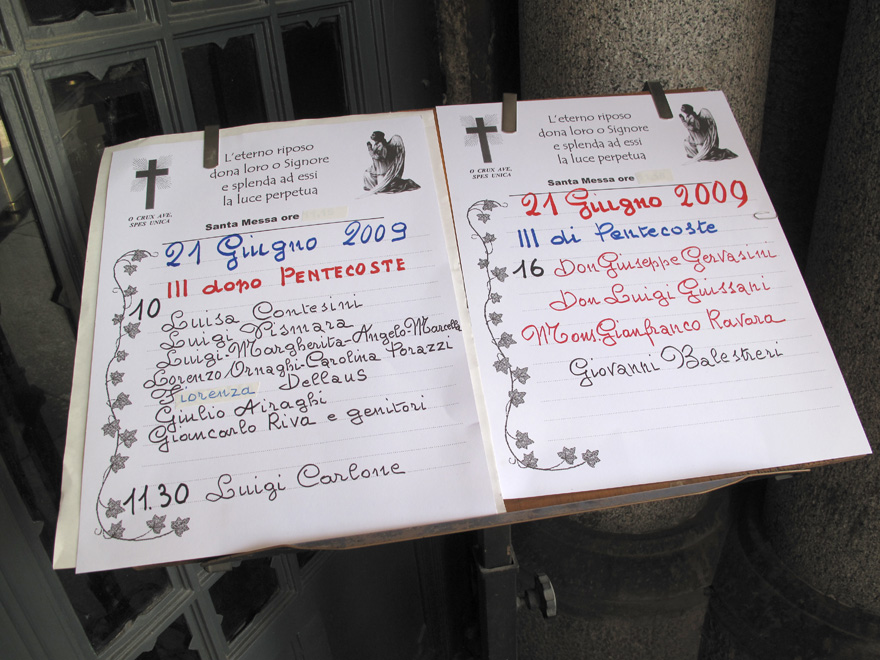
by Maureen | Jun 21, 2009 | Discoveries, Featured Articles, Photo of the Day
Milano’s Cimitero Monumentale – Monumental Cemetery – is beyond words. It rivals many museums of architecture and sculpture and offers a lesson one could spend years studying. The architectural periods and sculptural styles are diverse and magnificent! And to have them side-by-side provides a concentrated contrast hard to find elsewhere.
I had heard about it when here last summer, so I took the green line on the subway to the Garibaldi stop and headed in the general direction. The chaotic streets made it difficult to navigate, but I checked my map often.
The entrance building is palatial and I’m sure oft-photographed, but I immediately went deep into the old crypts seeking out those which are generally overlooked. What a study in Italian names! I found myself pronouncing each one quietly out loud, so for the following two hours the dead were having their names read aloud. The oldest burials were from the late 1800s; the cemetery was opened in 1866. The most recent grave I encountered was from just a few weeks ago.
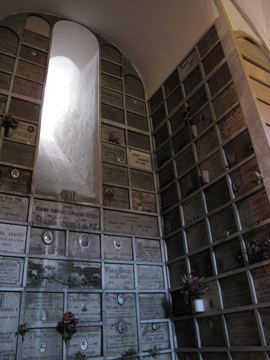
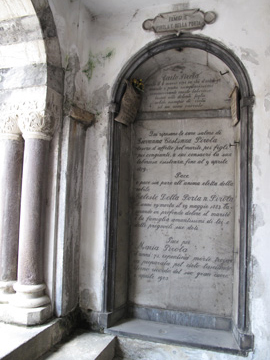
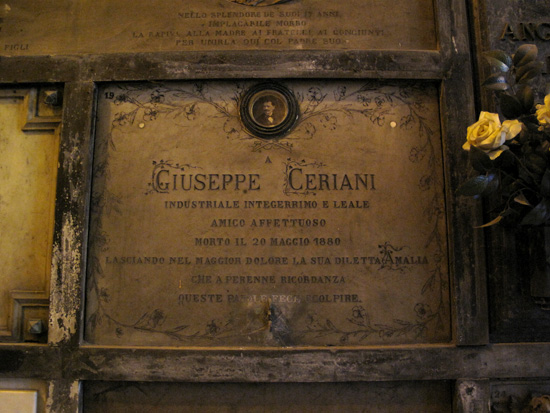
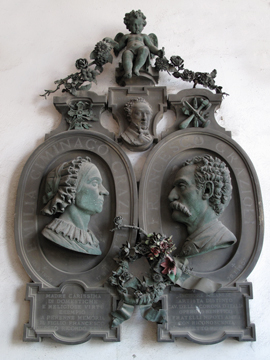
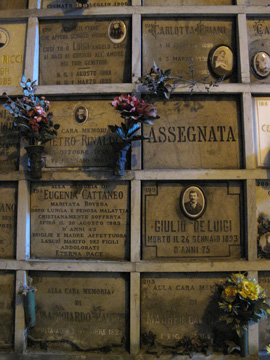
This woman’s name – Vittoria Colombo Carugati –
was never written in with much more than pencil.
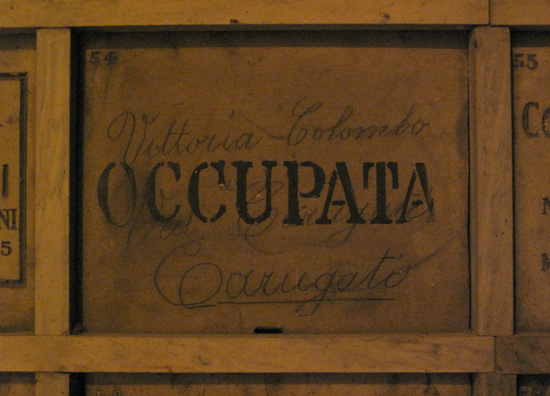
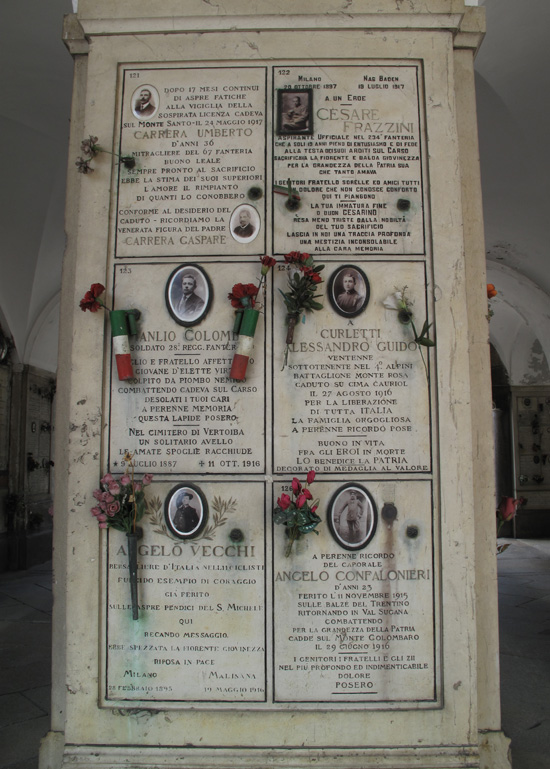
This memorial is perhaps the most startling that I saw. It shows two very emaciated men, barely draped and in a kiss at death. Both of them reach out to the hand of the woman seated near them. Wouldn’t you love to know THAT story!?
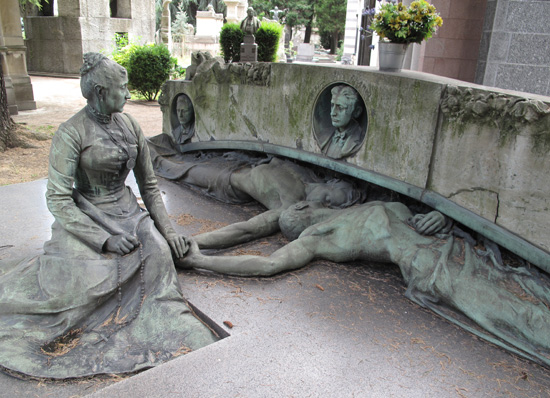
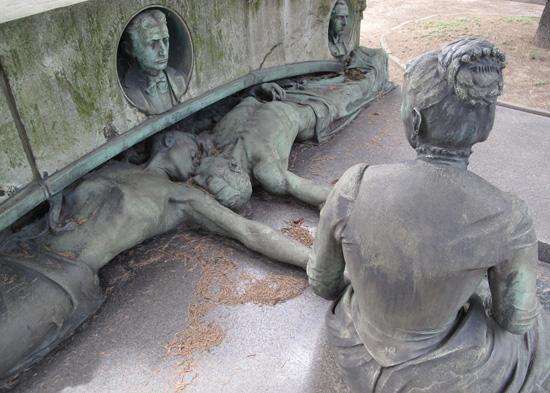
Some of the tombs are the size of a small apartment!
And the architectural styles cover the full gamut!
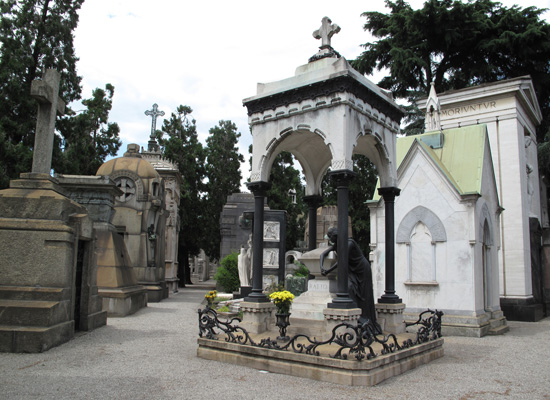
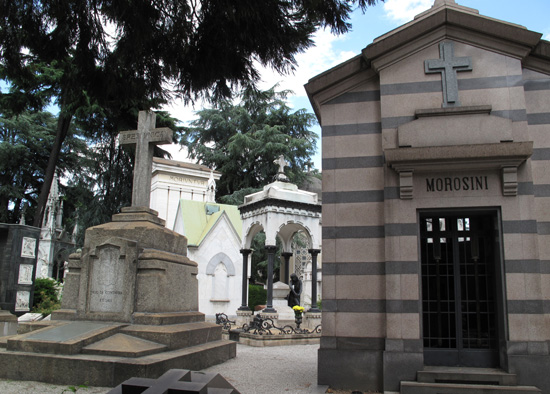
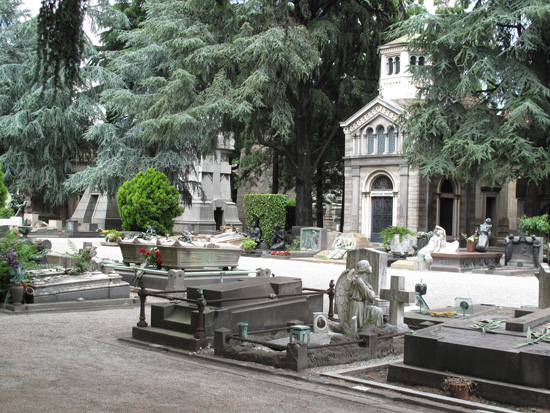
This is quite a modern memorial!
Other quite modern pieces were boxy enclosures of broad glass and stone.
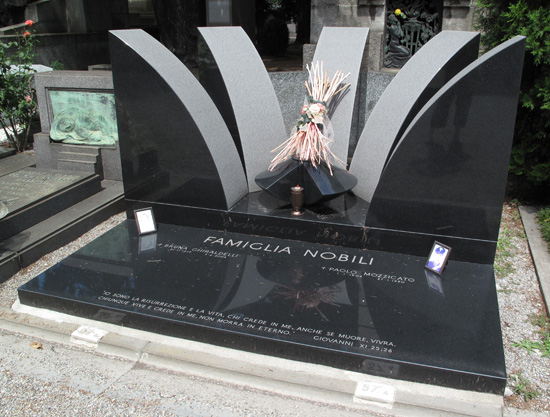
Near the grand entry, this memorial to an architect says across the top of one side, “Offer your spirit to God the redeemer. Offer your blood to your country.”
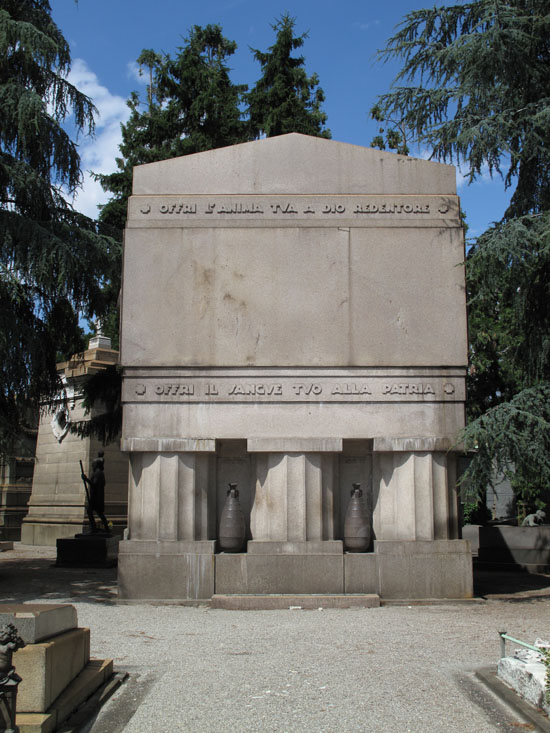
As I was leaving, I heard the unmistakable sound of vigil prayers. I followed the music of voices to a small chapel at the back and underside of the grand entry, and found a gathering of elder women praying for the repose of souls. “May perpetual light shine upon them.” Here are the names of those they were praying for today. (I love the decidedly European handwriting, all of one woman.)
